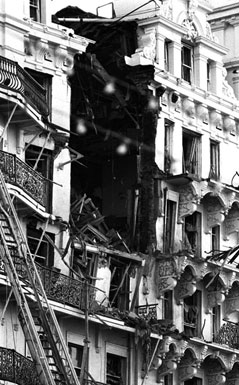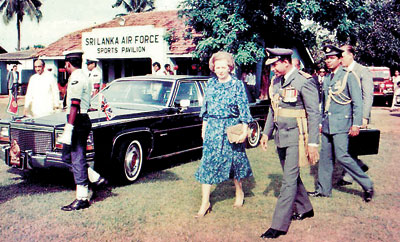News
Reminiscing Thatcher’s narrow escape in Brighton
View(s):By Prof. Ravindra Fernando
The Grand Hotel in Brighton in the south coast of England was built in 1864 for members of the upper classes visiting Brighton. One of the most expensive hotels in the town, it has 201 rooms and conference facilities for up to 800 guests in the Empress Suite.
During the weekend of September 14-17, 1984, Roy Walsh was a guest in room 629.
The reason why this guest stayed in the hotel and what he did was known to the world some three weeks later when a bomb went off at 2:54 a.m. on October 12 that year. It caused the mid-section of the building to collapse into the basement, leaving a gaping hole in the hotel’s façade. Fireman said many lives were saved because the well-constructed Victorian hotel remained standing, despite the central section of eight floors collapsing into the basement.

The bomb-devastated Grand Hotel in Brighton
The 43-year-old guest, whose real name was Patrick Joseph Magee, was a member of the Provisional Irish Republican Army (IRA). His plan was to assassinate Prime Minister Margaret Thatcher and her ministers, who were planning to have the Conservative Party conference in the hotel.
During his stay, he planted a bomb, fitted with a long-delay timer made from video recorder components, under the bath in room 629. The bomb had nine kilogrammes of Frangex (gelignite).
The plot to bomb the Grand Hotel in Brighton began in 1981 as an act of revenge for the stance Ms. Thatcher took over the death of Bobby Sands and other republican hunger-strikers who had demanded political status in prison. The IRA claimed responsibility the next day, and said that it would try again. Its statement read:
“Mrs. Thatcher will now realise that Britain cannot occupy our country and torture our prisoners and shoot our people in their own streets and get away with it. Today we were unlucky, but remember we only have to be lucky once. You will have to be lucky always. Give Ireland peace and there will be no more war.”
The blast badly damaged her bathroom, but left her sitting room and bedroom unscathed. When the bomb exploded, Ms. Thatcher was still awake in her suite, working on her conference speech for the next day. She had just completed her conference speech for the next day when her private secretary came in to hand her an official paper. Moments later, as she handed it back complete with her comments, the bomb exploded.
Walking across the landing, she called in to the room where a team of secretaries had been finishing typing her speech to check they had not been harmed. One of them, who had been using a photocopier at the time, had received an electric shock but was not badly hurt.
Their main concern, Lady Thatcher later recounted, was to reassure her that the speech, which had not yet been fully typed up, was still in one piece.
“It’s all right, we’ve got the speech,” they insisted, handing her a copy for her briefcase. Both she and her husband Denis escaped injury. She changed her clothes and was led out through the wreckage along with her husband and driven to Brighton police station.
Around 4 a.m., she left the police station, informing the BBC correspondent that the conference would go on as usual.
The narrowness of the Prime Minister’s escape was made clear when it was later claimed that she had only left the bathroom of the suite seconds before it was blown up. It was badly damaged, although in her memoirs she said that, had she been in there at the time, the worst she would have suffered would have been only cuts and bruises. “Those who had sought to kill me had placed the bomb in the wrong place,” said Mrs. Thatcher.
She began the next session of the conference sharp at 9.30 a.m. the following morning, as scheduled. “The bombing was an attempt to cripple Her Majesty’s democratically elected Government. The scale of the outrage in which we have all shared, and the fact that we are gathered here now-shocked, but composed and determined-is a sign not only that this attack has failed, but that all attempts to destroy democracy by terrorism will fail,” said Ms. Thatcher.
She left the conference to visit the injured at the Royal Sussex County Hospital. The bomb killed five – Conservative MP Sir Anthony Berry, Eric Taylor (North-West Area Chairman of the Conservative Party), Lady (Jeanne) Shattock (wife of Sir Gordon Shattock, Western Area Chairman of the Conservative Party), Lady Muriel Maclean (wife of Sir Donald Maclean, President of the Scottish Conservatives), and Roberta Wakeham (wife of Parliamentary Treasury Secretary John Wakeham). Thirty four people were wounded.
After electric cables were cut firemen used BBC arc lights to rescue Sir Norman Tebbit, the Trade and Industry Secretary from the rubble, in a painstaking operation that took several hours.
Entire Britain saw in breakfast television that morning pictures of the rescue. In the television footage a conscious Sir Tebbit, who was clearly in pain, was carried on a stretcher from the rubble, barefoot and wearing his pyjamas. It was one of the most enduring images of the bombing. When the hospital staff asked him whether he was allergic to anything, he famously answered “bombs”.
His wife Margaret suffered neck injuries. She was left permanently paralysed and has been confined to a wheelchair ever since.
The first woman prime minister of Britain Margaret Thatcher was elected to office in 1979, the year I went to Britain for my postgraduate studies at Guy’s Hospital Medical School, University of London. I watched daily the independent British television channels which always showed news about her – good and bad.
Dr. Iain West, my contemporary and with whom I had the honour of working in the nineties, was one of the foremost forensic pathologist in Britain at that time. Having scoured the rubble of the Grand Hotel, he was able to point detectives to the exact spot where the bomb had been hidden. Dr West was an inspirational teacher to the next generation of forensic pathologists, who succeeded Prof. Keith Mant under whom I trained at Guy’s. Dr. West helped recover and identify bodies from several terrorist bombings, including the Hyde Park (1982) and Harrods (1983) incidents in London.

A friend of Lanka: British Prime Minister Margaret Thatcher arriving at the Air Force ground in Colombo to board a helicopter on her way to open the Victoria dam in 1985. With her in the picture are Air Force Commander Dick Perera and Squadron Leader Ravi Arunthavanathan, the Aid de Camp. President Jayewardene is also in the picture.
After Dr. West indicated the exact room where the bomb was planted British police began to track down everyone who had stayed in the room. The police interviewed more than 800 current and previous guests and checked the backgrounds of all except Patrick Magee, whose fingerprints were found in the remains of the bathroom. On June 24, 1985, he was arrested in Glasgow, Scotland with other members of an IRA active service unit while planning more bombings.
Three months later, Magee was found guilty of planting the bomb, detonating it, and of five counts of murder. He received eight life sentences — seven for offences relating to the Brighton bombing, and the eighth for another bomb plot. The judge recommended that he serve at least 35 years, and branded him “a man of exceptional cruelty and inhumanity.”
However, Magee only served 14 years. He was released in 1999 under the terms of the 1998 Good Friday Agreement signed by Britain, Ireland and eight Northern Ireland political parties.
When the newly elected government of Ms. Thatcher decided a massive cut in expenditure in 1979, there was doubt whether Sri Lanka would get the funds from Britain to build the Victoria Dam. However, at the Commonwealth Heads Meeting in Lusaka in 1979 she confirmed to the Sri Lankan Prime Minister Ranasinghe Premadasa that the grant would be given. The Dam was built and she inaugurated it in 1985.
Follow @timesonlinelk
comments powered by Disqus



















